The first site for outdoor education in Ontario was the Albion Hills Conservation Area School in 1963, built as a residential site where students and teachers could live in nature for multiple days10. In 1965, the Ontario Education Act allowed school boards to buy land outside of their jurisdiction to run ‘out of classroom schools’11. This meant that school boards, like the York Region District School Board could purchase land outside of York Region to build outdoor education centres.
Science education, and particularly outdoor education, was a big focus for decision makers in school boards around the province from the 1970s to 1980s. Vivian Outdoor Resource Centre, the first outdoor education day use centre in York Region opened in 1972. In 1975, the Ontario Ministry of Education published a document called “Education in the Primary and Junior Divisions”, which supported outdoor education centers by suggesting that out-of-classroom activities should become a natural extension of in-classroom learning12.
 A timeline of major developments in Outdoor Education in York Region
A timeline of major developments in Outdoor Education in York Region
In the 1980s, the Ontario Ministry of Education published a document called “Science is Happening Here”, which gave advice to school boards in the province about policy decisions for science education in elementary school13. In response, the York Region Board of Education made Math and Science education a top priority for 6 years, and created the Mathematics/Science Priority Committee14. This committee provided funds towards outdoor education centres and certified teachers with the Ministry of Natural Resources.
In 1993, York Region District School Board approved Outdoor Education Policy and Procedure #350.0, confirming its support to provide students with opportunities to learn about the natural world through outdoor education15.
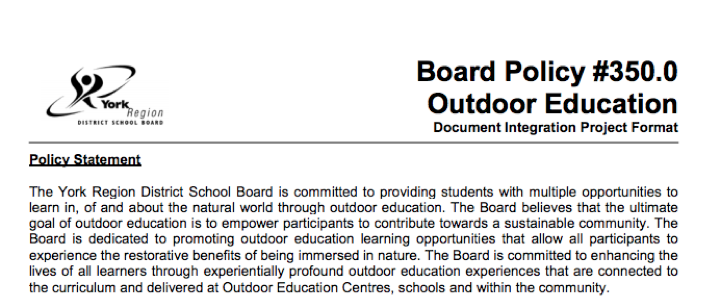 York Region District School Board’s 1993 policy on Outdoor Education
York Region District School Board’s 1993 policy on Outdoor Education
“That’s a goal of mine and always has been for kids to connect, care and make some of those changes towards environmental stewardship and citizenship. I think that’s the goal of outdoor ed. That’s always been the lens or place where I’ve come from."
- Jennifer Barton, Chair of Outdoor Education Committee 2000-2008
Activities in Outdoor Education
Students would take part in a variety of activities outdoors that taught them not only about nature, but about science, math, language, and arts as well. In the Web of Life program, students role-play as herbivores, omnivores, and carnivores, and learn about the importance of shelter, foraging for food and water, and wildlife adaptations by experiencing how animals survive in the wilderness16.
“We had a giant water beetle. I had never seen one before and this giant water beetle came up out of the water and he jumped just as the swallow went by. He hit the swallow. The swallow cartwheeled across the water. The beetle recuperated, grabbed the swallow and dragged it into the mud.”
- Bill Oliver, Instructor at B.O.R.C.
Students can verify information in field guides when observing nature at outdoor resource centres
Students also explored subjects like language and art outdoors as well17.
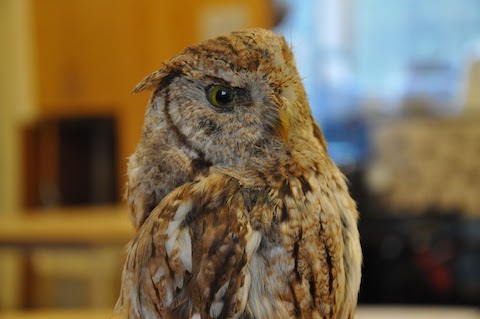
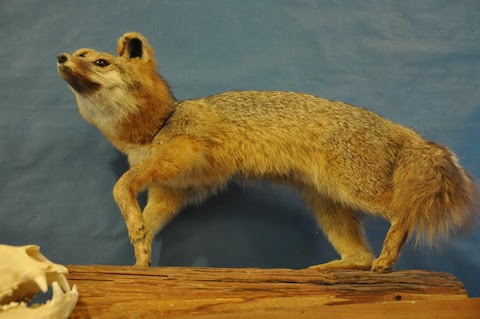 Taxidermy is a way to preserve an animal’s physical shape for students to study closely.
Taxidermy is a way to preserve an animal’s physical shape for students to study closely.
Learn about science, math, language, and arts with these outdoor games and activities the next time you are outside with your family and friends!
Outdoor Games and Activities - British Columbia Teacher’s Foundation
Concept of Outdoor Education
How did learning take place in outdoor resource centers?
Outdoor education is defined as an experiential process of learning by doing, which takes place primarily outdoors with the emphasis placed on understanding relationships between people and the environment18.
The teachers and staff at outdoor resource centres across Ontario use similar approaches to plan activities and lessons for visiting students in different grades. When Burrlington Outdoor Resource Centre was first opened, Malcom McRoberts, the first principal at the schoolhouse, wrote a manual that included the general design for classroom visits, which extended the learning experience outside of the outdoor resource centre, and into the student’s homeroom classrooms19. The general design includes: a pre-visit exploration in the student’s homeroom classroom, activities during the visit to the outdoor resource centre, and discussion and reflection after the student returns to their homeroom classroom20.
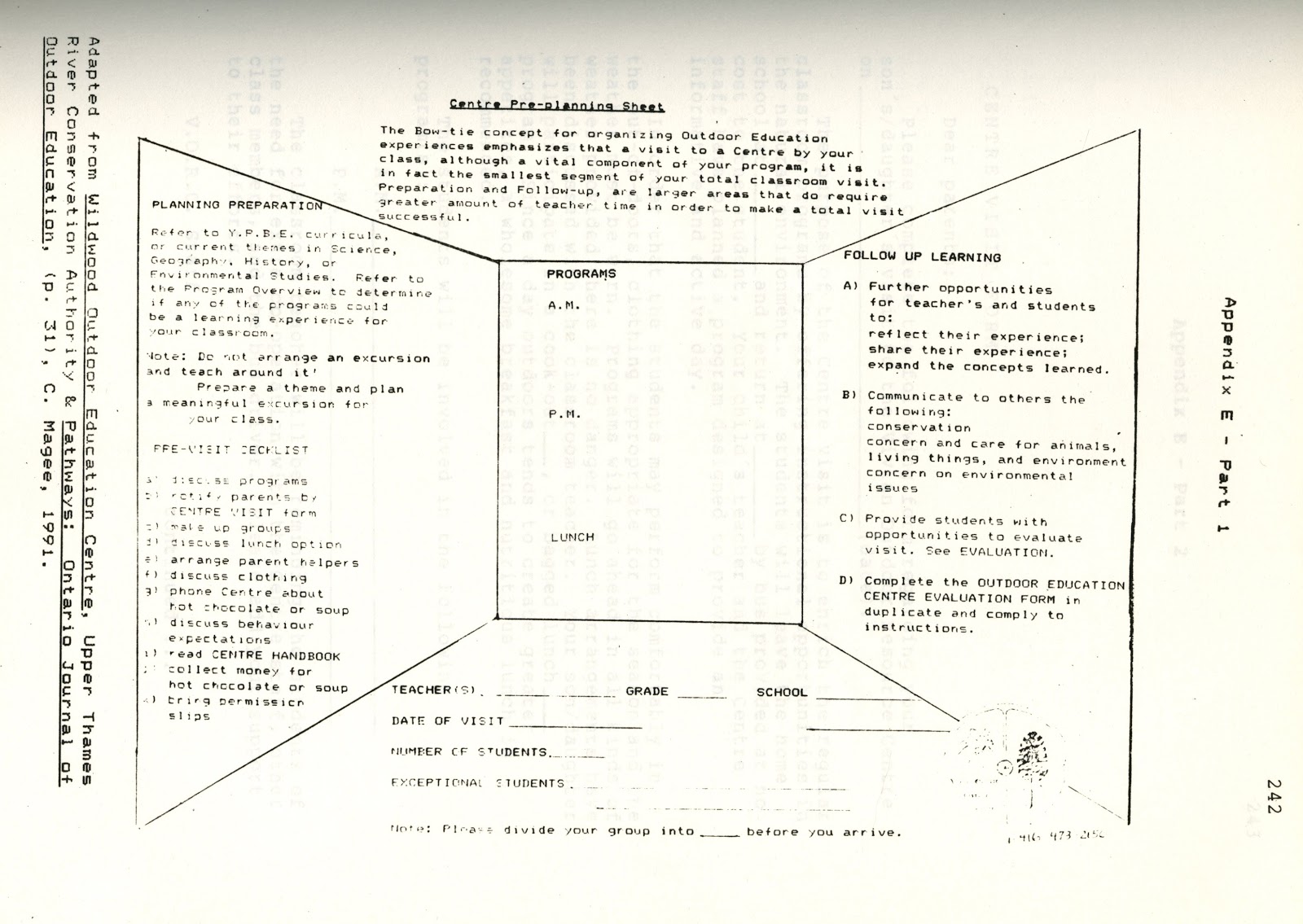
The shape of the Bow Tie Concept indicates the importance of pre-visit and post-visit reinforcement of the learning experience 21
Originally, Ralph Ingleton, a teacher at Forest Valley Outdoor Education Centre, in North York, Ontario, thought of this design for outdoor learning, and named it the Bow Tie Concept22.
“You can see the whole group, their eyes lighting up with wonder, curiosity and you just know that there is learning going on. They are getting the appreciation for nature.”
- Ron Ritchie, instructor at BORC
Outdoor education supports and enriches in-class learning by allowing students to experience learning opportunities outside of a traditional classroom setting. Students are able to test the importance of what they learn by applying information in real experiences and confirming its value. Afterwards, students write about their experiences while thinking about what they saw, smelled, and touched while learning about nature and the outdoors.
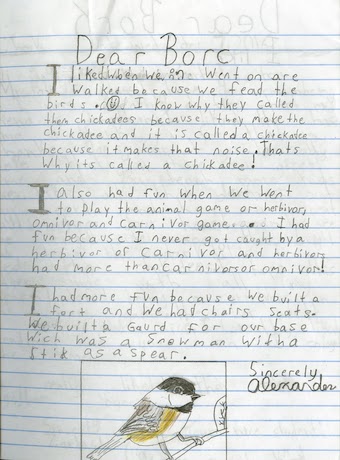 Students reflect on their experience at outdoor learning centres after their visit
Students reflect on their experience at outdoor learning centres after their visit
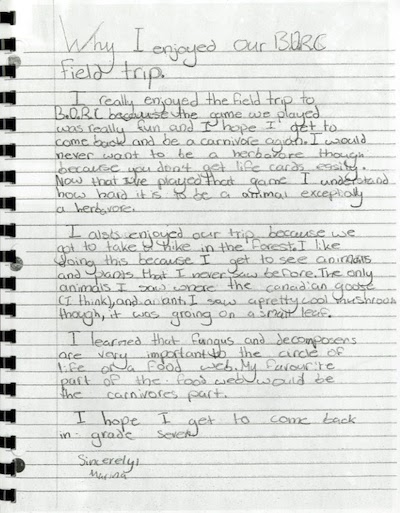
10 Significant Development in Local School Systems - W.G. Fleming (1972)
11 Baber Thesis
12 A Historical Geography of Ontario School Board Operated Outdoor Education Centres- Borland, 2015
13Baber Thesis
14Baber Thesis
15 Karen Fullbrook
16 Karen Fullbrook
17 Baber Thesis
18 Baber Thesis
19 Macrobert's Manual
20 Macrobert's Manual
21 Baber's Thesis scan
22 Baber's Thesis
Move along to celebrate 50 Years of Outdoor Education!